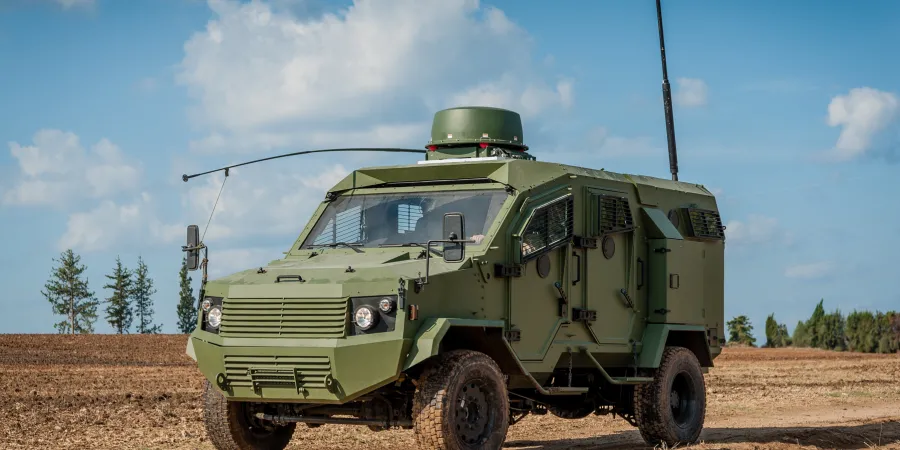Eurosatory 2018: Gaia to Present Two Families of Armored Vehicles
THUNDER is a family of multi-purpose 4x4 vehicles, capable of carrying up to 12 people and 1.8 tons of payload. AMIR is a 4x4 or 6x6 all-terrain mine-protected vehicle, capable of carrying a payload of up to 3 tons
Eyal Boguslavsky
| 01/06/2018
Gaia Automotive Industries, an Israeli developer of automotive defense products for various applications, will present its ‘THUNDER’ and ‘AMIR’ armored vehicles at EUROSATORY 2018 that will take place in Paris in mid-June.
THUNDER is a multi-purpose 4x4 armored vehicle that can carry up to 12 people and a payload of up to 1.8 tons. It is built on commercial chassis such as the F-550 Ford, and its crew compartment offers Level II/III, STANAG 4569 protection. Optional add-ons include fire-fighting systems in the engine and crew compartment; a night vision system; NBC filtration system, Remote Control Weapon Station (RCWS), gunner turret, and more.
AMIR is a multi-purpose 4x4 or 6x6 mine-protected vehicle that can carry up to 12 people and a payload of up to 3 tons. It has independent suspension for tactical mobility. Optional add-ons include manual one-man turret 12.7/20/25/40 mm caliber remote control weapon station; 81/120 mm mortar carrier; missile launcher/anti-tank missile launcher/anti-aircraft turret, and more. The AMIR can be bullet protected up to STANAG 4569 level 4 and up to 10 Kg TNT mine.
“Each of the THUNDER and AMIR vehicles offers a cost-effective solution with superior performance and protection relative to its price,” says Shlomi Shraga, Gaia Automotive’s CEO. “But more than that, what distinguishes our solutions is our ability to work with the customer to produce a vehicle that is tailored to their requirements. We are currently engaged in a number of vehicle assembly knowledge-transfer projects to customers in their own countries. Together with the client, we are working to establish assembly plants, creating jobs for locals and work for local subcontractors, allowing the client independence in managing the project, and reducing project costs by up to 25%. We are actively pursuing further such knowledge-transfer opportunities.”
THUNDER is a family of multi-purpose 4x4 vehicles, capable of carrying up to 12 people and 1.8 tons of payload. AMIR is a 4x4 or 6x6 all-terrain mine-protected vehicle, capable of carrying a payload of up to 3 tons
Gaia Automotive Industries, an Israeli developer of automotive defense products for various applications, will present its ‘THUNDER’ and ‘AMIR’ armored vehicles at EUROSATORY 2018 that will take place in Paris in mid-June.
THUNDER is a multi-purpose 4x4 armored vehicle that can carry up to 12 people and a payload of up to 1.8 tons. It is built on commercial chassis such as the F-550 Ford, and its crew compartment offers Level II/III, STANAG 4569 protection. Optional add-ons include fire-fighting systems in the engine and crew compartment; a night vision system; NBC filtration system, Remote Control Weapon Station (RCWS), gunner turret, and more.
AMIR is a multi-purpose 4x4 or 6x6 mine-protected vehicle that can carry up to 12 people and a payload of up to 3 tons. It has independent suspension for tactical mobility. Optional add-ons include manual one-man turret 12.7/20/25/40 mm caliber remote control weapon station; 81/120 mm mortar carrier; missile launcher/anti-tank missile launcher/anti-aircraft turret, and more. The AMIR can be bullet protected up to STANAG 4569 level 4 and up to 10 Kg TNT mine.
“Each of the THUNDER and AMIR vehicles offers a cost-effective solution with superior performance and protection relative to its price,” says Shlomi Shraga, Gaia Automotive’s CEO. “But more than that, what distinguishes our solutions is our ability to work with the customer to produce a vehicle that is tailored to their requirements. We are currently engaged in a number of vehicle assembly knowledge-transfer projects to customers in their own countries. Together with the client, we are working to establish assembly plants, creating jobs for locals and work for local subcontractors, allowing the client independence in managing the project, and reducing project costs by up to 25%. We are actively pursuing further such knowledge-transfer opportunities.”



